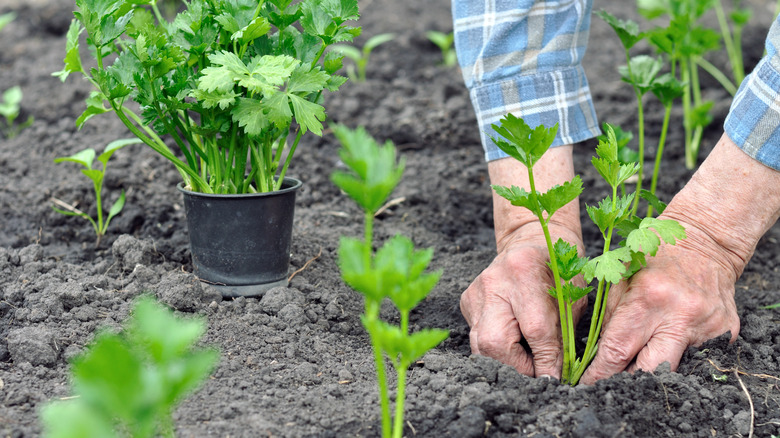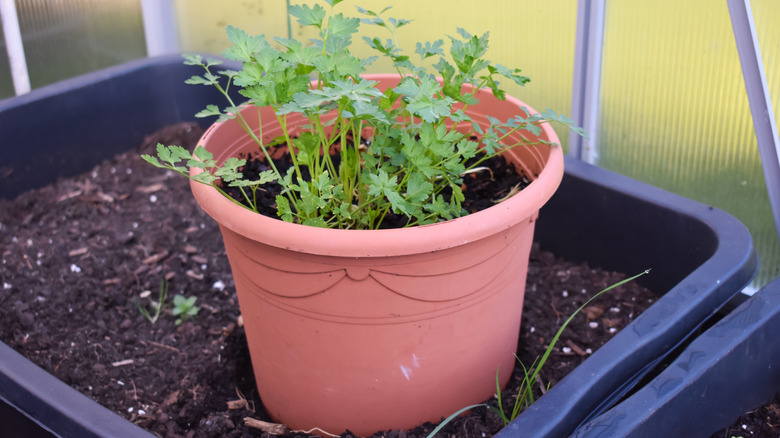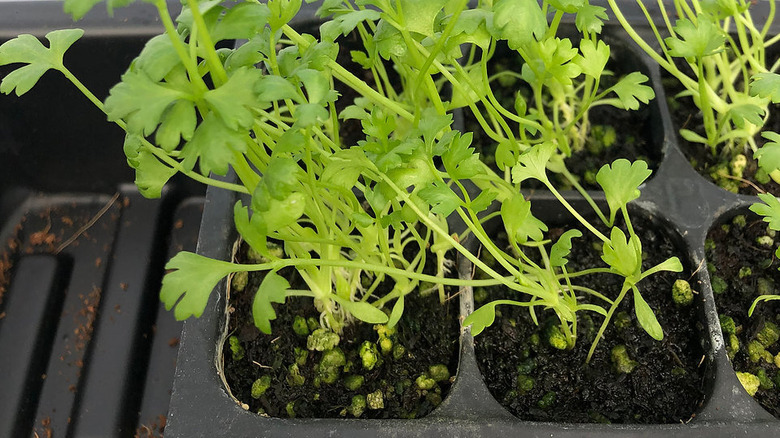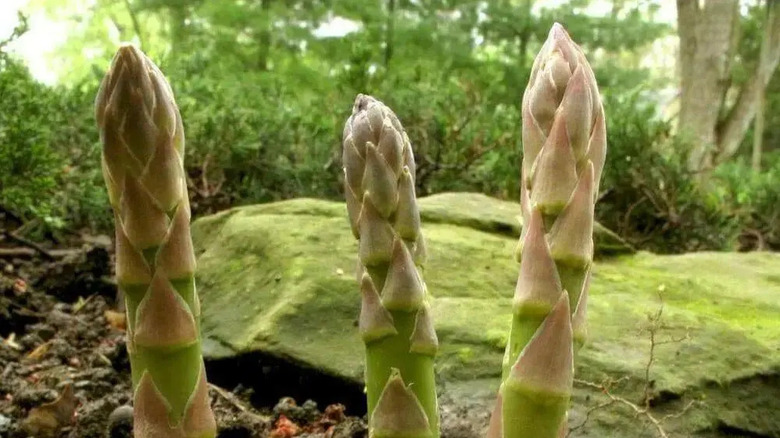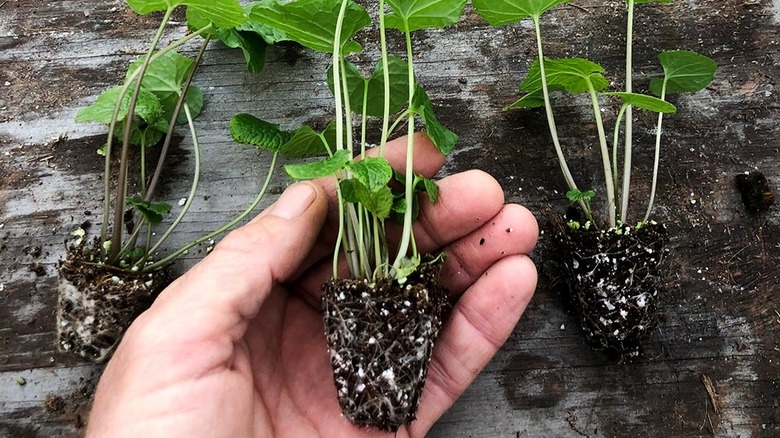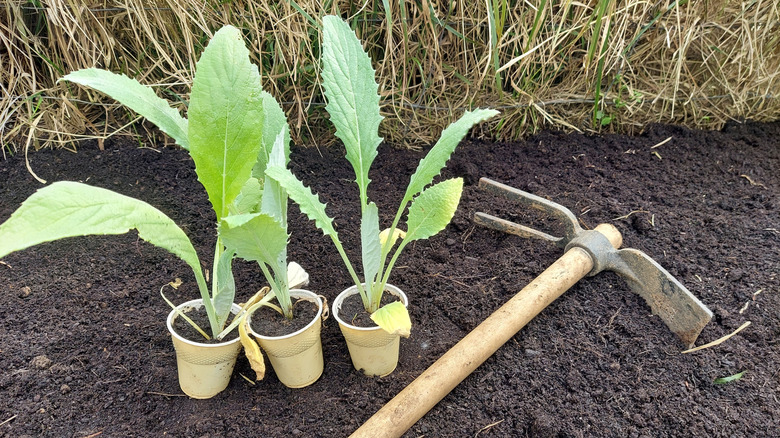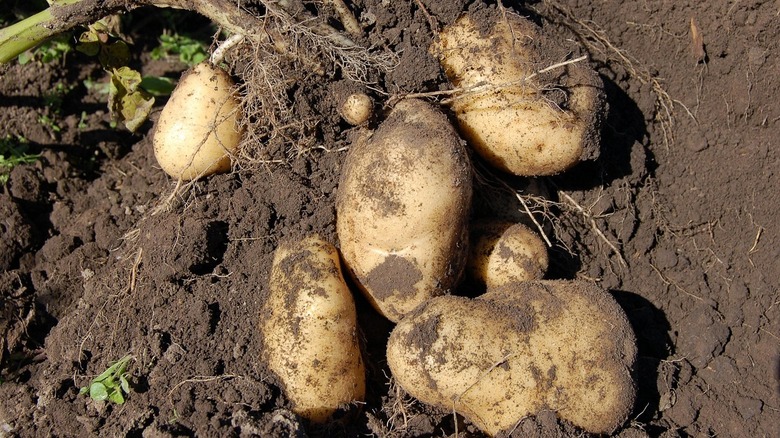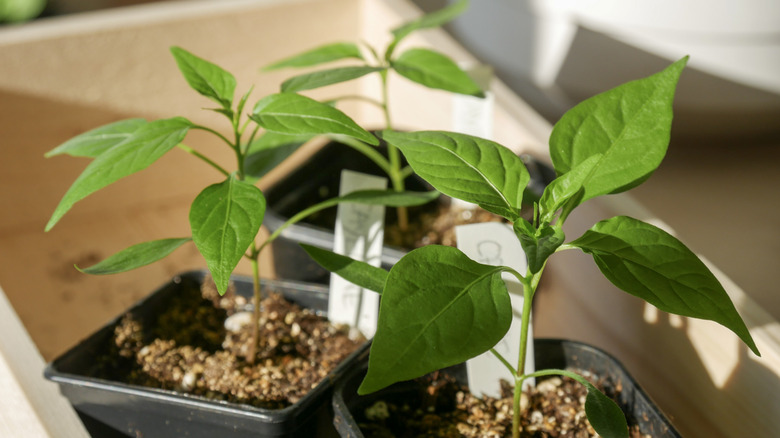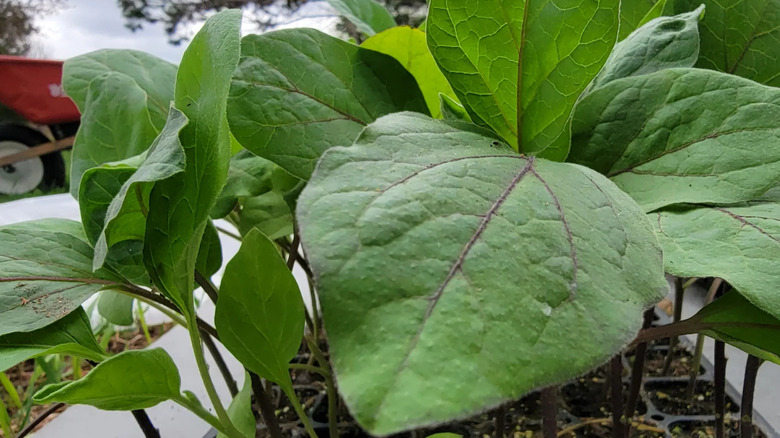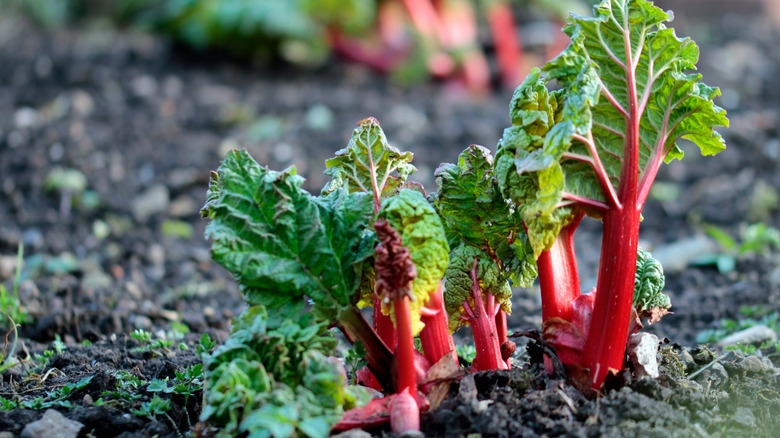9 Garden Vegetables That Aren't Worth Growing From Seed
Gardening is more of a science than many people realize. It takes thoughtful and strategic care to grow any plants, especially vegetables you intend to harvest for food. Things become even trickier when you attempt to grow vegetables from seed, as there's more room for error and mishaps along the way.
Below are nine vegetable plants that you may not want to grow from seeds. Growing from seed requires a few extra steps at the beginning, and even if you use tricks for increasing germination rates, you could come across other issues or long waiting periods along the way. Seeds can take extensive time to germinate, may not grow as intended, or may unknowingly not meet conditions for creating vegetables for consumption. Read on to learn about plants that are better off being propagated from tubers, seedlings, or young plants, so you can successfully cultivate them alongside vegetables that can be grown from seed in your own backyard garden.
Parsley seeds take almost a month to germinate
Whether you're growing parsley alongside vegetables or herbs, starting it from seed isn't an efficient approach. It takes around three weeks for parsley to germinate and up to two months to sow for planting. That's nearly three months of waiting before you can start harvesting leaves from this plant. Considering other herbs and vegetables are ready for harvest after a month, this can leave parsley straggling in comparison.
Parsley is a biennial plant that only lives for up to two years. Three months of that short lifespan is waiting for your plant to grow, making it even more disappointing when its life draws to a close. Instead of planting seeds, purchase young seedlings from a local nursery and plant them between February and May. The young plant should sprout edible leaves throughout the growing season and provide consistent harvests for the duration of its life. Fortunately, parsley is popular and you can find mature plants ready for harvest at most garden centers, local nurseries, and even grocery stores. It grows best in neutral to slightly acidic soil that's medium to rich in nutrients, and thrives in both indoor and outdoor gardens. Aside from the long germination, this plant doesn't take much effort regarding other needs and sunlight requirements.
Celery seeds take weeks to germinate and even longer to sow for planting
Celery seeds require even more patience than parsley before you can enjoy the fruits of your labor, taking a whopping three weeks to germinate and up to three months to sow for planting. This means that just as you're seeing the first sprouting stem of your parsley, celery seeds could still have a whole additional month before they start showing green. The biggest issue with this is that celery seeds need lots of sunlight to germinate, meaning they can't be buried very deep in the soil. Keeping birds, wild animals, and other pests from nabbing seeds can be difficult, especially if they're grown directly in an outdoor garden.
Don't put yourself through this extended wait period if you want homegrown vegetables sooner rather than later. Skip the germination and sowing and directly plant starter celery plants in your intended garden plot. Celery is also a biennial plant, meaning you'll only get up to two years out of this vegetable. Save yourself the headache of growing seeds year after year by planting seedlings in rich soil high in potassium around April or early May. Pick cultivars known for growing quickly in home gardens, such as the 'Conquistador' or 'Tango Hybrid.'
Asparagus seeds take a minimum of three years to provide harvests
Asparagus is a pain to grow from seed for more reasons than its extensive germination period (which takes three to five weeks). When growing from seed, there's no true way to tell if it's a male or female plant. If most of the seeds end up being female, gardeners get stuck with weed-like seedlings that are less productive and fruitful than their male counterparts. Female plants devote energy to growing red berries in addition to their edible spears, which results in fewer vegetables for consumption.
The most common approach to planting asparagus is transplanting one-year-old male crowns. Don't try regrowing asparagus from grocery store produce, but visit a legitimate gardening center instead. Most asparagus labeled under the 'Jersey' cultivar name are male, such as 'Jersey Giant' and 'Jersey Knight.' Males and females are hard to differentiate when asparagus is young, but as soon as they begin sporting flowers, you can tell which plants are females by their three-lobed stamen center. If you have trouble sourcing asparagus crowns, ensure a seed packet is a male-dominated cultivar to increase your chances of getting male plants. Seeds or seedlings should be placed in a deep garden plot with fertile, well-draining soil — asparagus lives for about 15 years, so be sure to choose a spot wisely.
Real wasabi seeds are hard to source and it's easy to get sold fake ones
Genuine wasabi is harder to source than most people realize; in fact, most of the wasabi found at restaurants and stores is actually a blend of horseradish, mustard, and other flavorings. The reason for this deception is that wasabi is difficult to grow, slow to produce, and harvests are quick to expire. The seeds often fail to germinate and many nurseries don't have seeds for sale. The only potentially findable seeds are typically the 'Daruma' or 'Mazuma' cultivars, which need strict temperature requirements to germinate. For example, 'Daruma' seeds have their best shot of germinating if kept at 41 degrees Fahrenheit for at least two months before transplanting. While not impossible to maintain, these strict requirements with no guarantee harvest may not be worth it. Another risk of purchasing and attempting to grow seeds is that many "wasabi" seeds are misleading. They may be advertised as wasabi plants, however, if you read the fine print, many of these products are just mustard seeds bred to taste similar.
Instead of taking the many risks associated with growing wasabi seeds, order authentic wasabi plants from a reliable retailer. Real Wasabi provides Wasabia Japonica "Daruma" Plant Starts in the months between April and October. This online brand warns that authentic plants are only available during this time and still take two to three years before they're mature enough to harvest. They're also difficult to grow, even once you pass the seed stage, as they thrive in conditions that mirror their natural alpine and shaded environment : a space that is cool, moist, and has indirect lighting throughout the day.
Artichoke seeds are not reliable and may not fruit even if they flower
Artichokes are known throughout the gardening world as being unreliable. Even if they flower in the springtime, you may have not met their vernalization requirements, meaning they won't grow fruit later in the growing season. Many plants flower before they fruit, which is what makes artichokes so deceiving. Unknowing, gardeners may see the gorgeous sphere-shaped cluster of rich purple flowers in spring and believe edible vegetables are also on the way. This leads to a disappointing letdown when nothing shows up in late summer. Another reason artichokes may not be worth growing from seed is that they require lots of room and have strict temperature requirements that, if not met, will lead to a disappointing harvest.
YouTuber Coastal Homestead also warns potential growers that, "Artichokes started from seed need two years to start producing." She continued, "According to the National Gardening Association, root divisions or starter plants are the best way to start a productive artichoke plant without the long wait." The 'Globe' artichoke cultivar is highly productive and recommended in USDA Zones 6 to 9, but could survive as an annual in Zone 5. It's grown as a perennial in Zone 6 and up. Reliable nurseries know how to vernalize these plants correctly, ensuring these transplants produce edible artichokes. Of course, this is assuming you're growing them in rich soil with consistent water and full sunlight.
Potato seeds will likely not produce the potatoes you buy at the grocery store
It's a well-known gardening hack that you can plant supermarket potatoes, but you may be wondering how to grow this vegetable from seed. This trick is so popular because it is the most efficient and promising method for growing potatoes. Seeds from potatoes are not clones of their parent plant, and may grow to taste and look very different. Gardeners typically only grow potatoes from seed to intentionally create new cultivars, so if you're looking to recreate what you pick up at the grocery store, you should probably skip growing potatoes from seed.
If your intentions are to simply have a thriving vegetable garden with homegrown fruit, grow potatoes from "seed potatoes," which are small tubers identical to their parent plant. You can find tubers at grocery stores, but you're better off sourcing your seed potatoes from a local nursery. Grocery store potatoes may be treated with chemicals to keep them dormant and more long-lasting, which could leave you waiting an unpredictably long time for new plants to emerge. Tractor Supply sells a DeGroot Bushel of Potatoes full of assorted seed potatoes, including Kennebec, Red Norland, and Russet Norkotah cultivars.
The hotter pepper varieties are, the longer they take to germinate
Hot peppers are a must-have vegetable for hot sauce and spice connoisseurs. Be warned that the spicier you like your peppers, the longer you may have to wait for them to grow. When planted as a seed, many hot peppers take anywhere from one to six weeks to germinate, with ghost pepper taking up to four months! If you aren't well-versed on hot pepper species, you may be thrown off when jalapeño peppers are already ready to be transplanted, but habañero haven't even sprouted. Gardeners also report very low germination rates in hot peppers on occasion, as they have very strict soil temperature requirements, needing the soil to be at least 80 degrees Fahrenheit. Waiting for months just to find that most of your pepper plants failed to germinate isn't worth the headache for most casual gardeners.
The best way to avoid these indeterminate germination times is to buy a hot pepper starter plant or to use cuttings from established mature plants. This ensures you're getting the exact pepper type you're looking for, removing the mystery around when it will germinate and how hot the plant will be. Home Depot carries various pepper plant starters, as there are many spicy peppers you can grow in your vegetable garden, from Bonnie Plants' Poblano Ancho Pepper Plants to their Red Ghost Super Hot Pepper Plants.
Eggplant seeds need a particularly warm climate to sprout
Eggplants, also known as aubergines, are vastly different than many other fruiting plant species. These various cultivars require a long period of warmth, rather than cold, to germinate. They must be kept in a minimum of 70 degree Fahrenheit temperatures, and many gardeners resort to starting them on a heated propagator, such as the iPower Seeding Heat Mat. If they don't germinate fast enough, these plants won't mature before the growing season is over. This is one of the biggest mistakes gardeners make growing eggplants in vegetable gardens. For beginning gardeners especially, growing eggplant from seeds may simply be too difficult.
Avoid the issues with germinating eggplant seeds by opting for a healthy foot-tall plant. Keep in mind that even at maturity, these plants are more finicky than tomatoes and other closely related vegetables. They may be difficult to grow past the seedling stage, especially if you live in a colder climate. Mulch is highly recommended to help them retain heat and moisture.
Rhubarb seeds aren't harvestable until up to two years after planting
Take the true test of patience by planting rhubarb from seeds. Rhubarb can't be harvested the first year after planting, and should be minimally harvested the following year as well, meaning it can be almost three years before the plants are truly mature and established. It may be tempting to harvest the plant prematurely, but it needs its foliage and stalks to establish a strong root system. As hard as it is to stay away from your rhubarb as it grows, it's necessary to ensure the plants have healthy and long lives ahead.
Avoid the years of waiting by purchasing a rhubarb that's already matured. Don't worry about accidentally buying a plant that's too old, since they live for about 10 to 15 years. Meaning that even when plants you're starting with are five years old, you can still get around a decade of vegetables out of them. 'Victoria,' 'MacDonald,' and 'Canada Red' varieties are known for having the largest yield and are often available at local nurseries and chain gardening stores. They grow best in the more moderate temperatures of USDA Zones 3 to 8.
